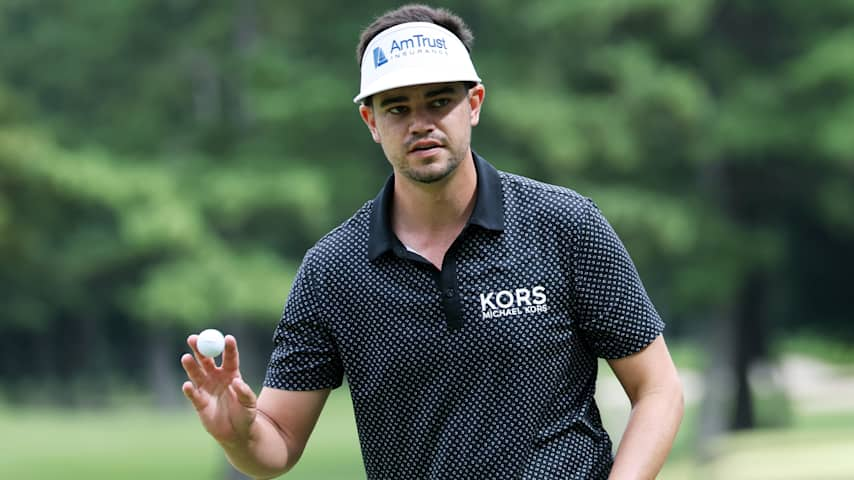Through the years: 10 memorable moments from PGA TOUR Q-School
8 Min Read

Written by Laury Livsey
PONTE VEDRA BEACH, Fla. – The last time a PGA TOUR-sanctioned Qualifying Tournament resulted in players earning PGA TOUR cards was in 2012, when South Korea’s D.H. Lee earned medalist honors by a shot at PGA West in La Quinta, California. Following the 2012 tournament, all subsequent Q-Schools only offered Korn Ferry Tour status. That all changes this week when the top-five finishers (and ties) will walk away from Sawgrass Country Club and TPC Sawgrass’ Dye’s Valley Course with PGA TOUR cards. The remainder of the field will be 2024 Korn Ferry Tour members.
The TOUR first held a Qualifying Tournament in 1965, at Palm Beach Gardens’ PGA National Golf Club, an eight-round tournament over two weeks that saw John Schlee take home medalist honors by beating John Josephson by three shots. Fifteen additional players also gained TOUR membership in that inaugural event. The Qualifying Tournament – often known as “Q-School” because in addition to the golf tournament, card-earners previously would attend classes designed to help them navigate the life of a golf professional – has been a constant in some fashion for nearly 60 years.
With the rewards of PGA TOUR membership returning this year, here are 10 memorable moments from past Q-Schools.
The credit union teller
Prior to the 1994 Korn Ferry Tour season, Woody Austin worked part-time as a teller at GTE Federal Credit Union in Tampa, Florida, to help pay the bills. He basically quit the job once he earned Korn Ferry Tour status and played well enough in 26 Korn Ferry Tour tournaments to finish 23rd on the money list. In late November 1994, Austin, then 31, traveled to Haines City, Florida, to play in the PGA TOUR Qualifying Tournament at Grenelefe Resort.
Austin carded rounds of 70-68-72-68-69-67 to win the tournament by four shots over Argentina’s Eduardo Romero. Austin pocketed $15,000 as tournament medalist and earned PGA TOUR membership for the first time. Austin returned to GTE Federal for one day after his Q-School heroics, needing to officially tender his resignation, which he did, taking with him an all-time reason for quitting: “I’m now a PGA TOUR golfer.”

Woody Austin would go on to compete in 545 events on the PGA TOUR, earning four wins. (J.D. Cuban/Getty Images)
A ‘perfect’ putt that missed
At the 2000 Qualifying Tournament at PGA West in California, Joe Daley encountered difficulty on the par-3 17th hole during his fourth round. After hitting his ball into the water and incurring penalty strokes, Daley faced a 4-foot putt for double bogey. He hit his putt dead center, yet the ball rammed against the back of the hole and repelled itself from where it came, staying out of the cup.
In disbelief, he threw his hat down and extended his hand in a “what just happened?” manner. Daley signed for a triple bogey-6 and then bogeyed the 18th hole, going from 5 under for the day to a 1-under 71 in a matter of 20 minutes. Daley followed with two closing 71s, finishing the 108 holes at 14-under to miss qualifying by one shot. He never regained TOUR membership.

Joe Daley makes catastrophic triple bogey at 2000 PGA TOUR Q-School
Remember the APG?
In 1968, touring professional golfers were at odds with the PGA of America. The players wanted to form their own organization, separate from the club professionals the PGA represented. At an impasse, the players created the Association of Professional Golfers, which lasted for six months until the players did end up creating their own organization but still under the PGA umbrella – today’s PGA TOUR. Because of that upheaval, there were three Q-Schools in 1968.
The PGA held its spring tournament at PGA National Golf Club, won by Bob Dickson, with future World Golf Hall of Famer Hale Irwin earning his card by finishing fourth in the eight-round tournament. In the fall, at the same course, Grier Jones was the medalist at the PGA’s second tournament. Hedging its bets against what might happen, the APG held its one and only “school” at Doral Resort in Miami, with the Netherlands’ Martin Roesink edging Robert Shaw by three shots. Eventually, all the players who earned cards at the three qualifiers received status for the newly revamped TOUR in 1969.
Hear ye, hear Y.E.
By the end of the 2008 season, South Korea’s Y.E. Yang was a familiar player at PGA TOUR events, making 43 starts and making headlines by winning once on the DP World Tour and four times on the Japan Golf Tour. Most notable was his 2006 HSBC Champions victory in Shanghai, China, where he defeated Tiger Woods by two strokes. Yet in December 2008, the 34-year-old Yang was at PGA TOUR Q-School for a second consecutive year and third time overall trying to re-earn his card.
Despite a tie for sixth a year earlier, Yang couldn’t keep his playing privileges, finishing 145th in the FedExCup. At the 2008 Qualifying Tournament, after a fifth-round 74, Yang was a stroke outside the top 25, the number of cards available. Yang recovered nicely on the final day at PGA West, shooting a 6-under 66. Yang was one of the last 10 players earn to his card, and he made the most of his opportunity, to say the least. He won twice on TOUR in 2009, including the PGA Championship by three strokes over Tiger Woods.

Y.E. Yang celebrates victory at 2009 PGA Championship
Only two under 70
How tough – and windy – was the 1969 Spring Qualifying Tournament held at PGA National in South Florida? Of the 15 qualifiers, including San Francisco’s Johnny Miller, only two players broke 70 in the 72-hole tournament. Gerry Preuss, on his way to a second-place finish, shot a third-round 69, while Jon Cutshall, who tied for seventh, opened with a 69. Tournament medalist Bob Eastwood posted rounds of 74-71-73-73.
Six medalists
Despite it being a six-round tournament, which usually helps separate players over 108 holes, there were an amazing six players tied for medalist honors at the 1992 Qualifying Tournament at TPC at The Woodlands and The Woodlands Inn and Country Club in suburban Houston. Massy Kuramoto, Skip Kendall, Brett Ogle, Perry Moss, Neale Smith and Jimmy Johnston all finished with 423 strokes.
Father and son: A 39-year gap
In 2016, Eric Cole earned Korn Ferry Tour status for the first time by tying for 23rd at the Qualifying Tournament at Orange County National in Winter Garden, Florida. Cole returned to Q-School in 2019 and was unsuccessful before regaining his Korn Ferry Tour privileges at the 2020 tournament, tying for 29th in Savannah, Georgia. Cole’s first Qualifying Tournament appearance in 2016 came 39 years after his father, South Africa’s Bobby Cole, was the medalist at the eight-round event at PGA National. The younger Cole thrived as a TOUR rookie in 2023, recording 14 top 25s and finishing No. 43 on the FedExCup.

Eric Cole’s epic year of hole-outs
Three years after he began playing …
The last three players to qualify at the 1973 Q-School were Warren Chancellor, Jim Blanks and a balding golfer from Georgia, Larry Nelson, who had been playing golf for just three years. Two years before he took up the sport, golf was the furthest thing from Nelson’s mind as he served as an infantry soldier in Chu Lai, Vietnam. When Nelson returned from the war, he took a job at Lockheed in Marietta, Georgia, and began hitting golf balls at a nearby driving range during his spare time.
His improvement was so dramatic he decided to give Q-School a try. “Ignorance is bliss in a lot of cases,” he said of his unlikely entry and even more unlikely success. Nelson finished his 144 Q-School holes at 9 over and 30 strokes behind medalist Ben Crenshaw, but it didn’t matter. Nelson earned his card, and the former “D” Company member in the 1st Brigade of the 46th Infantry flourished. A month after becoming a TOUR member, Nelson made his PGA TOUR debut at the end of the 1973 TOUR season (San Antonio Texas Open). A few weeks later he made his first cut, at the Walt Disney World Golf Classic, earning $356.
“Honestly, when I came out on the TOUR, I didn’t know much about the game at all, so I wasn’t in awe of anyone because I didn't know the history of anyone,” he added.
Nelson eventually played in 536 TOUR events, winning 10 times – including three major championships. He added 19 PGA TOUR Champions titles and four Japan Golf Tour titles in his World Golf Hall of Fame career.
A bogey-bogey-bogey finish
After earning national Freshman of the Year honors and turning in three All-American seasons at the University of Oklahoma, Anthony Kim decided to forego his senior year of college to turn pro. Kim had to go through all three stages of Q-School to get his card. He followed a tie for 13th at First Stage with medalist honors at Second Stage, qualifying for Final Stage at PGA West’s Nicklaus and Stadium Courses, both a short drive from where he grew up in La Quinta, California.
Those who follow golf have heard the horror stories about disaster finishes to tournaments that ruin a player’s chances at getting a card. Well, that happened to Kim, who made three consecutive bogeys to finish his sixth and final round at the Nicklaus Course – and that late stumble hardly registered. Kim still shot an even-par 72 to tie for 13th. At five months past his 21st birthday, Kim was the youngest in the field to earn his card that year.
What might have been
When the dust settled at the 1985 Qualifying Tournament, six players tied at 2-over 434: Mike Sullivan and Brian Claar (two current PGA TOUR Champions rules officials), along with Adrian Stills, Mike Gove, Ernie Gonzalez and Peter McWhinney. That forced officials to hold a playoff to eliminate one player to determine the fortunate five. McWhinney, an Australian from Brisbane, became the odd man out when he three-putted for bogey on the first extra hole. That was the 29-year-old McWhinney’s best shot. He never earned PGA TOUR membership, and his only PGA TOUR start came at the 1988 Open Championship, where he missed the cut.












